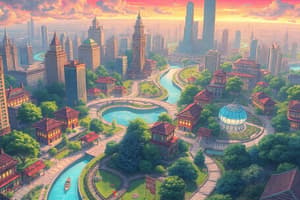Podcast
Questions and Answers
Who proposed the concept of the 'Garden City'?
Who proposed the concept of the 'Garden City'?
- Le Corbusier
- Sir Ebenezer Howard (correct)
- Clarence Perry
- Patrick Geddes
In which year was the book 'To-morrow' published?
In which year was the book 'To-morrow' published?
- 1902
- 1895
- 1898 (correct)
- 1896
The book 'To-morrow' was later republished under which title?
The book 'To-morrow' was later republished under which title?
- Cities of Future
- Urban Utopia
- Garden Cities of To-morrow (correct)
- Garden City Vision
What diagram did Howard use to explain his idea?
What diagram did Howard use to explain his idea?
The 'Three Magnets' diagram compares which elements?
The 'Three Magnets' diagram compares which elements?
Which of the following is NOT a feature of the Garden City concept?
Which of the following is NOT a feature of the Garden City concept?
What was the intended maximum population of a Garden City?
What was the intended maximum population of a Garden City?
What was the proposed land area for a Garden City?
What was the proposed land area for a Garden City?
The agricultural belt surrounding the city was to be:
The agricultural belt surrounding the city was to be:
Which English cities were developed based on the Garden City principle?
Which English cities were developed based on the Garden City principle?
Which of the following is an urban amenity proposed in the Garden City?
Which of the following is an urban amenity proposed in the Garden City?
Which class of people was to be provided housing in Garden Cities?
Which class of people was to be provided housing in Garden Cities?
The public buildings in Garden City were to be located:
The public buildings in Garden City were to be located:
Industries in the Garden City were to be located:
Industries in the Garden City were to be located:
What form of land ownership was proposed by Howard?
What form of land ownership was proposed by Howard?
The profits from land in Garden City were to be used for:
The profits from land in Garden City were to be used for:
The combination of town and country benefits refers to:
The combination of town and country benefits refers to:
The Garden City aimed to remove:
The Garden City aimed to remove:
Which one of these is a rural benefit highlighted in Garden City?
Which one of these is a rural benefit highlighted in Garden City?
Which planning model does the Garden City most closely resemble?
Which planning model does the Garden City most closely resemble?
The Garden City movement aimed to solve:
The Garden City movement aimed to solve:
The Garden City was a reaction to which country's industrial evils?
The Garden City was a reaction to which country's industrial evils?
According to Howard, the Garden City is:
According to Howard, the Garden City is:
Which facility was not explicitly mentioned as part of urban amenities in Garden City?
Which facility was not explicitly mentioned as part of urban amenities in Garden City?
The purpose of placing industries on the outskirts was to:
The purpose of placing industries on the outskirts was to:
Flashcards
Who proposed the Garden City?
Who proposed the Garden City?
Sir Ebenezer Howard proposed the Garden City concept.
When was "To-morrow" published?
When was "To-morrow" published?
"To-morrow" was published in 1898, outlining Howard's initial vision.
"To-morrow"'s republished title?
"To-morrow"'s republished title?
"To-morrow" was republished as "Garden City of To-morrow."
Howard's key diagram?
Howard's key diagram?
Signup and view all the flashcards
"Three Magnets" compare?
"Three Magnets" compare?
Signup and view all the flashcards
Industry location in Garden City?
Industry location in Garden City?
Signup and view all the flashcards
Garden City max population?
Garden City max population?
Signup and view all the flashcards
Land area for Garden City?
Land area for Garden City?
Signup and view all the flashcards
Purpose of agricultural belt?
Purpose of agricultural belt?
Signup and view all the flashcards
Cities based on Garden City?
Cities based on Garden City?
Signup and view all the flashcards
Proposed urban amenity?
Proposed urban amenity?
Signup and view all the flashcards
Who gets housing?
Who gets housing?
Signup and view all the flashcards
Location of public buildings?
Location of public buildings?
Signup and view all the flashcards
Where were industries located?
Where were industries located?
Signup and view all the flashcards
Proposed land ownership?
Proposed land ownership?
Signup and view all the flashcards
Where did Profits go?
Where did Profits go?
Signup and view all the flashcards
Town & Country combo?
Town & Country combo?
Signup and view all the flashcards
Garden City aimed to remove what?
Garden City aimed to remove what?
Signup and view all the flashcards
Rural area benefits?
Rural area benefits?
Signup and view all the flashcards
Planning model?
Planning model?
Signup and view all the flashcards
Problem the Garden City solved?
Problem the Garden City solved?
Signup and view all the flashcards
Response to which country's problems?
Response to which country's problems?
Signup and view all the flashcards
Rural meets Urban
Rural meets Urban
Signup and view all the flashcards
Missing facility?
Missing facility?
Signup and view all the flashcards
Why industries on outskirts?
Why industries on outskirts?
Signup and view all the flashcards
Study Notes
Overview of the Garden City Concept
- Sir Ebenezer Howard proposed the concept of the "Garden City."
- The book "To-morrow" was published in 1898 and later republished as "Garden City of To-morrow."
- Howard used "The Three Magnets" diagram to explain his idea.
- The "Three Magnets" diagram compares Town, Country, and Garden City.
Key Features of a Garden City
- Industries were located on the outskirts of the town, not in the city center.
- The population was limited to 30,000–35,000 people.
- Garden Cities are surrounded by a permanent agricultural belt of 3,000–5,000 acres.
- They aimed to combine rural and urban benefits.
- The proposed land area for a Garden City was 1,000 acres.
- Urban amenities include schools and hospitals.
- Housing was provided for all classes of people.
- Public buildings were located in the central court.
Land Ownership and Benefits
- Howard proposed cooperative or trust-based land ownership.
- Profits from land were to be used for uplifting the community.
- The combination of town and country benefits refers to the Garden City magnet.
Aims and Objectives
- The Garden City aimed to remove urban congestion.
- Rural benefits included fresh air and gardens.
- It most closely resembles a self-sufficient radial city planning model.
- The Garden City movement aimed to solve the urban-rural imbalance.
- The Garden City was a reaction to Britain's industrial evils.
- Howard viewed the Garden City as a compromise between village and city life.
- Placing industries on the outskirts was to prevent city congestion.
Implementation
- Letchworth and Welwyn are examples of English cities that were developed based on the Garden City principle.
- Mentioned urban amenities included recreation centers and theatres.
Studying That Suits You
Use AI to generate personalized quizzes and flashcards to suit your learning preferences.




